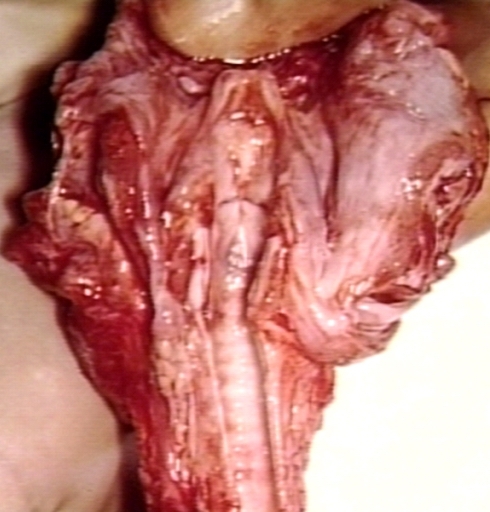Epiglottitis: Difference between revisions
No edit summary |
No edit summary |
||
| Line 56: | Line 56: | ||
[[Category:Medical emergencies]] | [[Category:Medical emergencies]] | ||
[[Category:Bacterial diseases]] | [[Category:Bacterial diseases]] | ||
[[Category:Disease state]] | |||
[[Category:Mature chapter]] | |||
[[Category:Pulmonology]] | |||
[[Category:Otolaryngology]] | |||
[[Category:Pediatrics]] | |||
[[Category:Infectious disease]] | |||
[[Category:Emergency medicine]] | |||
[[de:Epiglottitis]] | [[de:Epiglottitis]] | ||
Revision as of 10:56, 29 July 2011
| Epiglottitis | |
 | |
|---|---|
| Epiglottitis, Acute, Viral Etiology; Sudden Stridor and Obstruction in a Child. Image courtesy of Professor Peter Anderson DVM PhD and published with permission © PEIR, University of Alabama at Birmingham, Department of Pathology | |
| ICD-10 | J05.1 |
| ICD-9 | 464.3, 476.1 |
| DiseasesDB | 4360 |
| eMedicine | emerg/169 emerg/375 ped/700 |
| MeSH | D004826 |
For patient information click here
Editor-In-Chief: C. Michael Gibson, M.S., M.D. [1]
Please Take Over This Page and Apply to be Editor-In-Chief for this topic: There can be one or more than one Editor-In-Chief. You may also apply to be an Associate Editor-In-Chief of one of the subtopics below. Please mail us [2] to indicate your interest in serving either as an Editor-In-Chief of the entire topic or as an Associate Editor-In-Chief for a subtopic. Please be sure to attach your CV and or biographical sketch.
Overview
Epiglottitis is inflammation of the epiglottis - the flap that sits at the base of the tongue, which keeps food from going into the trachea (windpipe). Due to its place in the airway, swelling of this structure can interfere with breathing and constitutes a medical emergency. The infection can cause the epiglottis to either obstruct or completely close off the windpipe.
Cause
Epiglottitis involves bacterial infection of the epiglottis, most often caused by Haemophilus influenzae type B, although some cases are attributable to Streptococcus pneumoniae or Streptococcus pyogenes.
Symptoms
Epiglottitis typically affects children, and is associated with fever, difficulty swallowing, drooling, and stridor. It is important to note however that since the introduction of the Hemophilus Infuenzae vaccination in many Western countries (including th UK), the disease is becoming relatively more common in adults. The child often appears acutely ill, anxious, and has very quiet shallow breathing with the head held forward, insisting on sitting up in bed. The early symptoms are insidious but rapidly progressive, and swelling of the throat may lead to cyanosis and asphyxiation. Cases in adults are most typically seen amongst abusers of crack cocaine and have a more subacute presentation.
Diagnosis
Diagnosis is confirmed by direct inspection using laryngoscopy, although this may provoke airway spasm. The epiglottis and arytenoids are cherry-red and swollen. The most likely differential diagnostic candidates are croup, peritonsillar abscess, and retropharyngeal abscess.
On lateral C-spine X-ray, the thumbprint sign is a finding that suggests the diagnosis of epiglottitis.[1]
Treatment
Epiglottitis requires urgent endotracheal intubation to protect the airway. Ideally, this should be performed by an experienced anesthesiologist or respiratory therapist, with otolaryngology back-up in case of failed intubation. If intubation fails, tracheotomy is required.
In addition, patients should be given an antibiotic drug such as ceftriaxone or chloramphenicol either alone or in association with penicillin or ampicillin for streptococcal coverage.
Complications
Some patients may develop pneumonia, lymphadenopathy or septic arthritis.
References
- ↑ Jaffe JE. Acute Epiglottits. eMedicine.com. Available at: http://www.emedicine.com/Radio/topic263.htm. Accessed on: December 21 2006.
External links
- Jordana Marinoff, "Bacteria Grab a Windpipe and Hold it Hostage," Boston Globe, January 10 2006
Template:Respiratory pathology Template:SIB